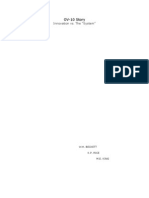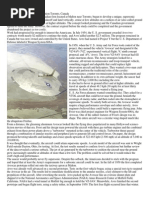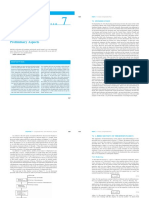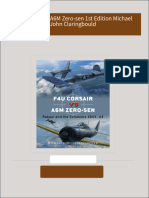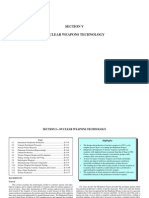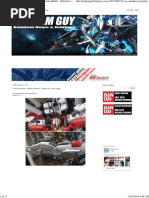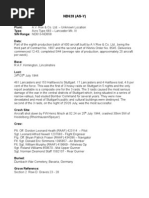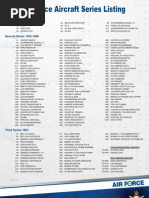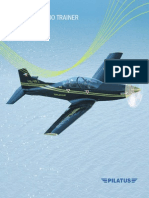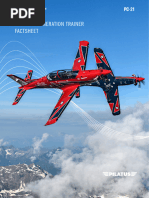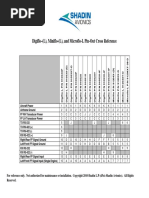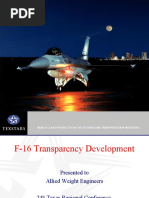(Contents) : J7W1 Imperial Japanese Navy Interceptor Shinden
(Contents) : J7W1 Imperial Japanese Navy Interceptor Shinden
Uploaded by
Mark AbCopyright:
Available Formats
(Contents) : J7W1 Imperial Japanese Navy Interceptor Shinden
(Contents) : J7W1 Imperial Japanese Navy Interceptor Shinden
Uploaded by
Mark AbOriginal Title
Copyright
Available Formats
Share this document
Did you find this document useful?
Is this content inappropriate?
Copyright:
Available Formats
(Contents) : J7W1 Imperial Japanese Navy Interceptor Shinden
(Contents) : J7W1 Imperial Japanese Navy Interceptor Shinden
Uploaded by
Mark AbCopyright:
Available Formats
1-1.
Actual Aircraft Specifications
1 J7W1 Imperial Japanese Navy Interceptor Shinden
In May of 1944, as the enemy's long-distance bomber attacks grew more intense by the day, the Japanese Navy felt the need increasing for the
deployment of a new, stronger short-range interceptor craft. And so at last there was an official declaration to Kyushu Aircraft from the
Japanese Navy for the development of a prototype craft for just that purpose.
It was in that instant that the legend of the 'Shinden' was born, whose uniqueness would surpass all else in the history of Japanese aircraft from
then on.
At the top of that request, the following was inscribed. "A superior high-speed land based fighter aircraft capable of mastering the shooting
down of the enemy's bombers."
It was the full scope lingering in this brief sentence that cause such great pressure and distress for Kyushu Aircraft's development team.
And then, one young Navy Engineering Officer offered a novel idea in response to that request. "A single-engined monoplane with forward
airfoils." This was not just new or novel - it was an aircraft shape that had never been seen before.
It was an unprecedented creation, with the main wings on the rear of the body, equipped with a 6 blade propeller for the propulsion engine, and
with a maximum speed of 400kt (750km/h) at an altitude of 8,700 meters.
It boasted a climbing power capable of reaching an altitude of 8,000 meters in under 10 minutes, 30 seconds, and a service ceiling of over
12,000 meters. For its firepower, 30mm machine guns were concentrated in a 4-way configuration on the nose, allowing maximum destructive
force. In short, it was a plan to recover from the current state of the war in one breath, using the superior speed for a attack-and-retreat tactic
against the enemy's impregnable large-scale bombers.
At that time, it was surely a craft that rose above even the most ambitious of ideas.
Photograph Provided By: AIREVIEW
But the moment was already too late, and its development was unable to proceed without delays. It become more and more difficult to source
materials and components. Add to that the shortage of skilled workmen, and the resultant succession of failures in the development of the
engine, the time and labor involved with the equipping and maintenance of the machine guns, and faced with the continuing pressure of heavy
bombing by formations of B-29s, at last the end of the war came about.
( Contents )
If only the Shinden had been able to fight...
As the last and strongest fighter craft that the Japanese Navy thought to deliver to the world as its final trump card, the Shinden continues to
give us such imaginings and suppositions.
The following is a chronicle of the details relating to the manufacture and development. We would be delighted if it helps fuel your imaginings of
the incredibly unique fighter aircraft called the 'Shinden'.
1st Section Actual Aircraft Specifications / Engine /
Cockpit / Machine Guns・・・・・・・・・・・・・3 Development Progress of Test Production 'Shinden' Specifications
Development Unofficially Announced: Feb, 1944 Style: Land Based Aircraft / Year of Production: 1945
Development Officially Announced: May, 1944
2nd Section Assembly Information・・・・・・・・・・・・・・5
Crew: One
Basic Research Started: Jul, 1943 Completed: Jan, 1944 Number Produced: Two
First Wind Tunnel Tests and Actual Size Glider Tests carried out at the Navy's Produced By: Kyushu Aircraft KK, Fukuoka City, Fukuoka
First Technical Depot. Engine: Ha.43-42 Type (MK9D Modified)
3rd Section Assembly Explanation Project Started: Feb, 1944
Mitsubishi Industries 18-Cylinder radial air cooled propulsion,
2,030HP liftoff output
Propeller: Sumitomo VDM constant speed (propulsion) 6 blade
Wooden Form Inspection: First: Jul, 1944 Second: Sep, 1944 propeller
3 - 1 Engine ・・・・・・・・・・・・・・・・・・・・・・・6
Design Drafting: Started: May, 1944 Completed: Nov, 1944
In November, 1944 and February, 1945, a German technician from Henschel & Aircraft Performance
3 - 2 Cockpit ・・・・・・・・・・・・・・・・・・・・・・11
Son visited because of this craft. After considering his opinions and with mass
production considered to be the main objective, drafting of modified designs was Maximum Speed: 405 Knots (750km/h) /Altitude: 8,700m 240 Knots
begun, however these were only about 80% complete when the war ended.
(444km/h)
3 - 3 Main Structure / Machine Guns・・・・・・・14
Various Testing Wind Tunnel Tests: Oct, 1944 Altitude: 3,000m Cruising Speed /Ascending Speed: 750m per minute
Cruising Altitude: 12,000m
Engine Cooling Tests: (by partial testing apparatus based on designs) May,
3 - 4 Equipping the Engine・・・・・・・・・・・・・19
1945
Aircraft Dimensions
Firing Tests: (by partial testing apparatus based on designs) Aug, 1945
3 - 5 Body Panels・・・・・・・・・・・・・・・・・・・24 Strength Tests: Started: Mar, 1945 Completed: Aug, 1945
Wingspan: 11.11m / Total Height: 3.92m
Total Length: 9.66m / Wing Area: 20.5m2
3 - 6 Landing Devices・・・・・・・・・・・・・・・・27
Manufacture Started: Oct, 1944
The strength test apparatus and crafts one and two were started almost at the
Weight
3 - 7 Wings & Final Outfitting・・・・・・・・・・・30
same time with virtually no space between them.
Empty Weight: 3,645kg / Loaded Weight: 4,928kg
Structural Inspection: First: May, 1945 Second: Apr, 1945
Transport of 1st craft to airfield: (Mushiroda Airfield, Fukuoka) Jun, 1945 Armament
4th Section Coloring ・・・・・・・・・・・・・・・・・・・・・・34 Inspection of Completed Craft: Jul, 1945 Guns: Type 5 30mm fixed machine guns x 4 (60 bullets each)
7.9mm fixed guns for training x 2 camera gun x 1
Although the craft was transported to the airfield on June 15th, several flaws Bombs: 60kg (#6) x 4 or 30kg (#3) x 4
were found in the fuselage and engine, which required roughly a month to fix,
meaning the final inspection was carried out after that.
5th Section Parts List・・・・・・・・・・・・・・・・・・・・・・38 Test Flight: Aug, 1945
(End)
August 3rd: First Test Flight
August 6th: Second Test Flight
August 8th: Third Test Flight
2. ZOUKEI-MURA INC. PRESENTS SUPER WING SERIES® no.01 1/32 J7W1 Imperial Japanese Navy Interceptor Shinden ZOUKEI-MURA INC. PRESENTS SUPER WING SERIES® no.01 1/32 J7W1 Imperial Japanese Navy Interceptor Shinden 3.
You might also like
- Zenith CH 701Document72 pagesZenith CH 701tetra195860100% (26)
- AM4 Fuel Efficiency Rate Per PassengerDocument9 pagesAM4 Fuel Efficiency Rate Per PassengerCleiton Negoseke100% (2)
- A Maritime Kill Web Force in the Making: Deterrence and Warfighting in the 21st CenturyFrom EverandA Maritime Kill Web Force in the Making: Deterrence and Warfighting in the 21st CenturyNo ratings yet
- The Development, Design and Construction of Gliders and Sailplanes by A LippischDocument72 pagesThe Development, Design and Construction of Gliders and Sailplanes by A LippischSPNXYZ100% (1)
- Ekranoplans - Back in BusinessDocument8 pagesEkranoplans - Back in BusinessJony CNo ratings yet
- OV 10 StoryDocument16 pagesOV 10 StoryUSMC_AnglicoNo ratings yet
- Employment of FPV Drones - A New Paradigm in Drones' Warfare_Brig Anshuman Narang CENJOWSDocument27 pagesEmployment of FPV Drones - A New Paradigm in Drones' Warfare_Brig Anshuman Narang CENJOWSmercy calloNo ratings yet
- Avro CanadaDocument1 pageAvro CanadaElie ObeidNo ratings yet
- Ublications NCDocument6 pagesUblications NCNguyễn Văn HoaNo ratings yet
- Ejection Seats: Sir James Martin, FellowDocument4 pagesEjection Seats: Sir James Martin, FellowAkay BayatNo ratings yet
- Feasibility Study For A Littoral Corvette Ship PDFDocument9 pagesFeasibility Study For A Littoral Corvette Ship PDFjNo ratings yet
- 1968 6 EngDocument17 pages1968 6 EngTateNo ratings yet
- AFW - US Navy Part 1Document2 pagesAFW - US Navy Part 1Giora MinorNo ratings yet
- Air International 08.2020Document92 pagesAir International 08.2020Giuseppe100% (1)
- Brochure Hornet V8Document20 pagesBrochure Hornet V8fowac11731No ratings yet
- The US Navy's Transition To JetsDocument12 pagesThe US Navy's Transition To JetsMike StreckertNo ratings yet
- Crusader Ares Star Fighter FINAL PDFDocument13 pagesCrusader Ares Star Fighter FINAL PDFtempNo ratings yet
- Commando, Fleetwing BT 12, Douglas A 20 Havoc,: JL Mcclellan: P51 Draft P 1 of 32Document32 pagesCommando, Fleetwing BT 12, Douglas A 20 Havoc,: JL Mcclellan: P51 Draft P 1 of 32Kliment VoroshilovNo ratings yet
- Helicopteros 00mDocument17 pagesHelicopteros 00mpfylNo ratings yet
- Get H6K “Mavis”/H8K “Emily” vs PB4Y-1/2 Liberator/Privateer: Pacific Theater 1943–45 Edward M. Young free all chaptersDocument66 pagesGet H6K “Mavis”/H8K “Emily” vs PB4Y-1/2 Liberator/Privateer: Pacific Theater 1943–45 Edward M. Young free all chaptersbillilbledan100% (2)
- Future NavyDocument23 pagesFuture NavyMarcelo MartinezNo ratings yet
- The M1A2 Abrams: The Last Main Battle Tank?: by Stanley C. CristDocument3 pagesThe M1A2 Abrams: The Last Main Battle Tank?: by Stanley C. CristAli ShiekhNo ratings yet
- Car 7Document5 pagesCar 7JoeNo ratings yet
- VayuDocument104 pagesVayuKarthikeyanNo ratings yet
- Youngester Magazine 30 - October - 2010Document13 pagesYoungester Magazine 30 - October - 2010V2No ratings yet
- Next-Generation Surface-Combatant DesignDocument34 pagesNext-Generation Surface-Combatant DesignPaulo HesselNo ratings yet
- Air Commando Journal Vol 1 Issue 3Document60 pagesAir Commando Journal Vol 1 Issue 3Fpaulo36No ratings yet
- World War II in The Pacific and The Impact On The U.S. NavyDocument4 pagesWorld War II in The Pacific and The Impact On The U.S. NavyThe Wilson CenterNo ratings yet
- Foxtrot to Arihant – The Story of Indian Navy’s Submarine ArmFrom EverandFoxtrot to Arihant – The Story of Indian Navy’s Submarine ArmNo ratings yet
- 1966 Shrike SidsDocument4 pages1966 Shrike Sidsmaruka33No ratings yet
- Woomera BomberDocument8 pagesWoomera Bomber117kitchenerNo ratings yet
- Planing Craft: The Editor Dr. Daniel SavitskyDocument29 pagesPlaning Craft: The Editor Dr. Daniel SavitskyAkbar Adi WijayaNo ratings yet
- DSC 1618 - DST Submarine Report PRO4 LRDocument24 pagesDSC 1618 - DST Submarine Report PRO4 LRUnknown11No ratings yet
- Alternative Naval Force Structure: CimsecDocument33 pagesAlternative Naval Force Structure: CimsecRudibert Kilian100% (1)
- Star Trek Command 1 Ships and Weapons and TerranDocument67 pagesStar Trek Command 1 Ships and Weapons and TerranZeke100% (4)
- Jim Larsen - 75th Year of Naval Aviation. Pistons To Jets (1987)Document41 pagesJim Larsen - 75th Year of Naval Aviation. Pistons To Jets (1987)Stotza100% (2)
- (Ebook) Harpoon Missile vs Surface Ships by Lon Nordeen ISBN 9781472859235, 1472859235 all chapter instant downloadDocument86 pages(Ebook) Harpoon Missile vs Surface Ships by Lon Nordeen ISBN 9781472859235, 1472859235 all chapter instant downloadonayamayleeNo ratings yet
- Harpoon Missile vs Surface Ships US Navy Libya and Iran 1986 88 1st Edition Lon Nordeen 2024 scribd downloadDocument71 pagesHarpoon Missile vs Surface Ships US Navy Libya and Iran 1986 88 1st Edition Lon Nordeen 2024 scribd downloadrotvikaveril100% (1)
- AirForces Monthly 2022-12 (417) (E)Document100 pagesAirForces Monthly 2022-12 (417) (E)Toma Hrg100% (1)
- Fatigue CrackDocument11 pagesFatigue CrackNiraj AnandNo ratings yet
- Pistons To JetsDocument41 pagesPistons To JetsRon Downey100% (2)
- Stones: Smart Bombs in VietnamDocument3 pagesStones: Smart Bombs in VietnamSebastian ArdilesNo ratings yet
- Ah 195703Document68 pagesAh 195703Ron Downey100% (1)
- Design and Manufacturing of Vertical Takeoff and Landing, Unmanned Aerial VehicleDocument7 pagesDesign and Manufacturing of Vertical Takeoff and Landing, Unmanned Aerial Vehicleshani.gujjarNo ratings yet
- OtomelaraDocument20 pagesOtomelaraTasnikNo ratings yet
- The Starfleet Museum - Dragon ClassDocument8 pagesThe Starfleet Museum - Dragon ClassJames Tiberius HenkelNo ratings yet
- The Market For Airborne ASW Sensors: Product Code #F672Document18 pagesThe Market For Airborne ASW Sensors: Product Code #F672Gautam NatrajanNo ratings yet
- Buy ebook F4U Corsair vs A6M Zero-sen 1st Edition Michael John Claringbould cheap priceDocument40 pagesBuy ebook F4U Corsair vs A6M Zero-sen 1st Edition Michael John Claringbould cheap priceotwayraska26No ratings yet
- Lookback Flying Wings-part 1 SmDocument44 pagesLookback Flying Wings-part 1 Smeth65141No ratings yet
- 1 s2.0 S2214785320369194 MainDocument6 pages1 s2.0 S2214785320369194 MainJaliJaNo ratings yet
- 100 Years of SailplanesDocument24 pages100 Years of SailplanesEric RaymondNo ratings yet
- Nuclear Weapons Technology - (Unkn Govt. PubDocument119 pagesNuclear Weapons Technology - (Unkn Govt. Pubapi-3708163No ratings yet
- ScientificAmerican 1914 AircraftWarDocument6 pagesScientificAmerican 1914 AircraftWarSkif DakNo ratings yet
- Evolution of Modern AircraftDocument410 pagesEvolution of Modern Aircraftsearchtyagi100% (94)
- KAVIYANDocument29 pagesKAVIYANBhuvaneshwaran MSNo ratings yet
- Hof 8Document106 pagesHof 8Lavern SipinNo ratings yet
- aast_2024031813573106Document20 pagesaast_2024031813573106chujcietogrzanNo ratings yet
- 3-3. Start Assembling The Main Structure and Machine GunsDocument1 page3-3. Start Assembling The Main Structure and Machine GunsMark AbNo ratings yet
- How To Attach Decals: Shinden ShindenDocument1 pageHow To Attach Decals: Shinden ShindenMark AbNo ratings yet
- Shinden 34 35Document1 pageShinden 34 35Mark AbNo ratings yet
- Formation Lights and Pitot Tube Attaching The Propeller: OptionDocument1 pageFormation Lights and Pitot Tube Attaching The Propeller: OptionMark AbNo ratings yet
- 3-6. Start Assembling The Landing Devices: Front GearDocument1 page3-6. Start Assembling The Landing Devices: Front GearMark AbNo ratings yet
- Oil Cooler + Side Panels Equipping The Engine: Right Interior Right ExteriorDocument1 pageOil Cooler + Side Panels Equipping The Engine: Right Interior Right ExteriorMark AbNo ratings yet
- Supercharger Engine + Elongated Cylinder + Forced Cooling FanDocument1 pageSupercharger Engine + Elongated Cylinder + Forced Cooling FanMark AbNo ratings yet
- 3-5. Start Assembling The Body Panels: Nose Panels Rear PanelsDocument1 page3-5. Start Assembling The Body Panels: Nose Panels Rear PanelsMark AbNo ratings yet
- 3-4. Start Equipping The Engine: Main WingsDocument1 page3-4. Start Equipping The Engine: Main WingsMark AbNo ratings yet
- Whole Cockpit: Instrument PanelDocument1 pageWhole Cockpit: Instrument PanelMark AbNo ratings yet
- 3-2. Start Assembling The CockpitDocument1 page3-2. Start Assembling The CockpitMark AbNo ratings yet
- 60 00 Raiser - Return The WorldDocument12 pages60 00 Raiser - Return The WorldMark AbNo ratings yet
- WWW - Zoukeimura.co - JP: Assembly ManualDocument1 pageWWW - Zoukeimura.co - JP: Assembly ManualMark AbNo ratings yet
- 60 00 Raiser - Painted BuildDocument12 pages60 00 Raiser - Painted BuildMark AbNo ratings yet
- 35 EX-S Gundam - WIP Painted Build - Updated With More ImagesDocument17 pages35 EX-S Gundam - WIP Painted Build - Updated With More ImagesMark AbNo ratings yet
- 32 Shinden 2nd Edition Ah! My Goddess - Products - Zoukei-Mura IncDocument8 pages32 Shinden 2nd Edition Ah! My Goddess - Products - Zoukei-Mura IncMark Ab0% (1)
- Shinden 2nd Edition: Ah! My GoddessDocument1 pageShinden 2nd Edition: Ah! My GoddessMark AbNo ratings yet
- Belldandy & Urd: Race Queen VerDocument1 pageBelldandy & Urd: Race Queen VerMark AbNo ratings yet
- GUNDAM GUY - Gunpla Builders World Cup (GBWC) 2013 - Champions Announced! PDFDocument6 pagesGUNDAM GUY - Gunpla Builders World Cup (GBWC) 2013 - Champions Announced! PDFMark AbNo ratings yet
- PG 1/60 RX-0 Unicorn Gundam - New Images (Updated 11/23/14) : Order HereDocument88 pagesPG 1/60 RX-0 Unicorn Gundam - New Images (Updated 11/23/14) : Order HereMark AbNo ratings yet
- 35 Scale RX-78-2 Gundam Battle Damage - Diorama Semi Scratch BuildDocument12 pages35 Scale RX-78-2 Gundam Battle Damage - Diorama Semi Scratch BuildMark AbNo ratings yet
- 6 Scale MSH 06 - The Humansize - Custom BuildDocument51 pages6 Scale MSH 06 - The Humansize - Custom BuildMark AbNo ratings yet
- Gundam Meaningless War - GEARS OnlineDocument2 pagesGundam Meaningless War - GEARS OnlineMark AbNo ratings yet
- GUNDAM GUY - All Japan 'ORA-ZAKU' Championship 2013 - Gunpla Category Winners PDFDocument2 pagesGUNDAM GUY - All Japan 'ORA-ZAKU' Championship 2013 - Gunpla Category Winners PDFMark AbNo ratings yet
- Model Aircraft - September 2020Document86 pagesModel Aircraft - September 2020Chris W. BalmerNo ratings yet
- ND628Document1 pageND628mattbouchNo ratings yet
- Newsletter PDFDocument41 pagesNewsletter PDFDragan SorinNo ratings yet
- RAAF Series Poster A3Document1 pageRAAF Series Poster A3grayadamNo ratings yet
- EA-6B Research by LangleyDocument6 pagesEA-6B Research by LangleydemontisNo ratings yet
- I. Propeller and Spinner Group A. Centroid of PROPELLER Section A (In ) X' (In) Y' (In) Ax' (In ) Ay' (In )Document56 pagesI. Propeller and Spinner Group A. Centroid of PROPELLER Section A (In ) X' (In) Y' (In) Ax' (In ) Ay' (In )Gil Christian De DiosNo ratings yet
- RIL Index 07-Aug-19Document30 pagesRIL Index 07-Aug-19Jivendra KumarNo ratings yet
- Eastman Turbo Oils Engine ApprovalsDocument1 pageEastman Turbo Oils Engine Approvalszijianwu.chinaNo ratings yet
- Part Number PrefixesDocument6 pagesPart Number PrefixesBobby ChippingNo ratings yet
- SM-28T Machete LC Uae 2022Document2 pagesSM-28T Machete LC Uae 2022StavattiNo ratings yet
- Application Charts 6 2018Document7 pagesApplication Charts 6 2018EleazarNo ratings yet
- Pilatus PC 9 Fact SheetDocument2 pagesPilatus PC 9 Fact Sheetethanhunt92100% (1)
- Pilatus Aircraft LTD PC 21 FactsheetDocument2 pagesPilatus Aircraft LTD PC 21 FactsheetX XmartNo ratings yet
- RAF History.Document15 pagesRAF History.idkhow2playthisNo ratings yet
- D10 - A320 Family Customer Presentation Programme - FM1302305 - v1Document7 pagesD10 - A320 Family Customer Presentation Programme - FM1302305 - v1IDINAHNo ratings yet
- CFM Leap MarketDocument8 pagesCFM Leap MarketlifefullpassionNo ratings yet
- Data Training Baru 132251Document27 pagesData Training Baru 132251Hardiansyah SiregarNo ratings yet
- Institute of Engineering and Technology: Philippine State College of AeronauticsDocument1 pageInstitute of Engineering and Technology: Philippine State College of AeronauticsElla Louise BarcelonaNo ratings yet
- B747-8 FSM PDFDocument7 pagesB747-8 FSM PDF이봉연No ratings yet
- Inventario J. García - Actualizado - 5Document24 pagesInventario J. García - Actualizado - 5Juan José RequeNo ratings yet
- Lockheed Twin SeriesDocument17 pagesLockheed Twin SeriesGiora MinorNo ratings yet
- Biggest: OUR Catalog of 2021!Document20 pagesBiggest: OUR Catalog of 2021!Earl PattersonNo ratings yet
- Tapa de Llenado 2evl3078p4ey9kxaDocument14 pagesTapa de Llenado 2evl3078p4ey9kxaDanielEscobarMontecinosNo ratings yet
- TOPCAT Aircraft Database 14 JAN 2013Document2 pagesTOPCAT Aircraft Database 14 JAN 2013Peter Fabian100% (1)
- FuelflowpinoutDocument1 pageFuelflowpinoutBiblioteca Brasil AviationNo ratings yet
- Thank You.: Texstars, Inc. TEL: 972.647.1366 FAX: 972.641.2800Document24 pagesThank You.: Texstars, Inc. TEL: 972.647.1366 FAX: 972.641.2800Balwinder GherhaNo ratings yet
- Images Stories Contents 050 enDocument249 pagesImages Stories Contents 050 enrolf_brNo ratings yet
- AvBuyer Magazine May 2023Document140 pagesAvBuyer Magazine May 2023forcetenNo ratings yet





